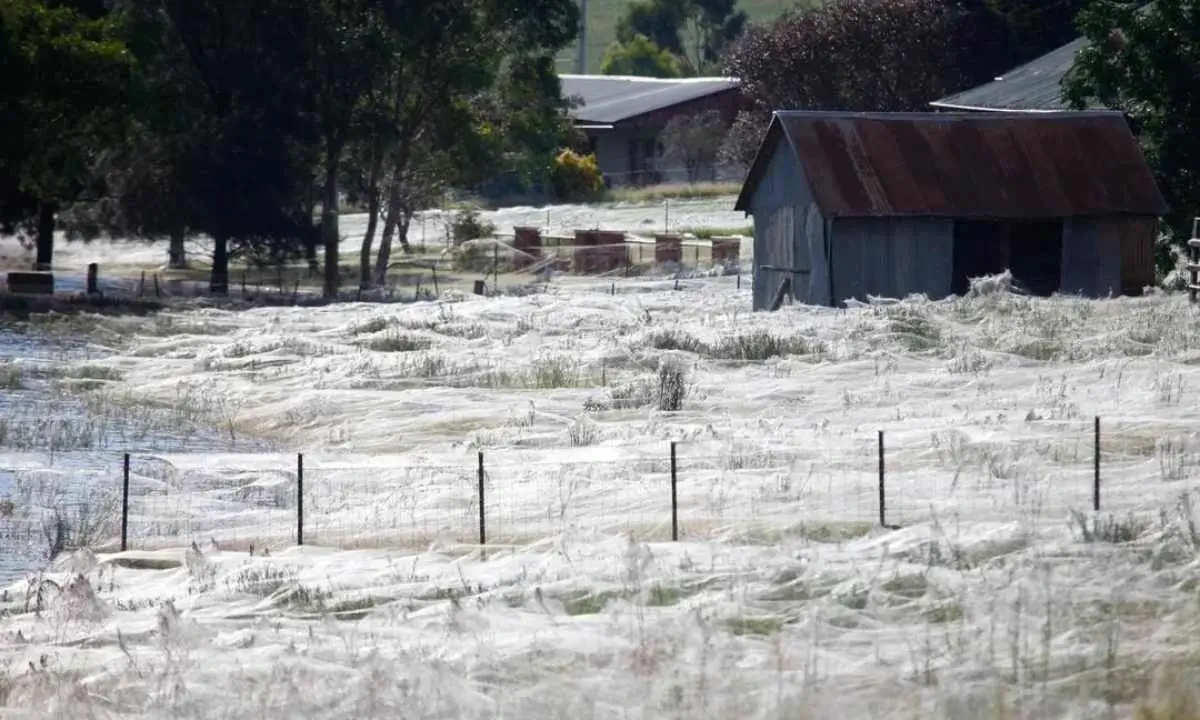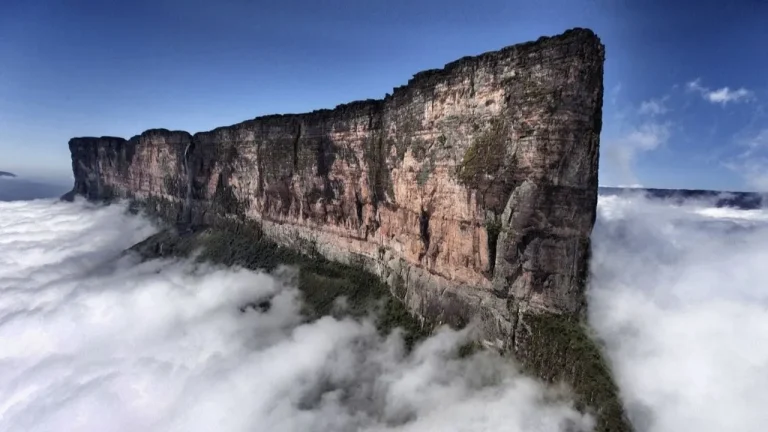Massive Spider Webs Blanketed Australia!
Australia is known for its unique and sometimes extreme wildlife encounters. But few could be stranger than the sight that greeted people in parts of Victoria in 2021. Following the heavy rainfall and flooding, large areas of Gippsland were once covered in massive spider webs. These “blanket webs” covered fields, trees, and roads, stretching for kilometers in some areas. Let us now find out more about this bizarre phenomenon.
How the Spider Webs Formed
The vast spider webs in Australia resulted from a behavior known as “ballooning.” Ballooning occurs when spiders release silk strands into the air, which catch the wind and carry them to new locations. Spiders use This common dispersal technique, especially when they need to escape unfavorable conditions. In this case, the heavy rain and subsequent flooding in Victoria triggered a mass ballooning event. The spiders sought higher ground to avoid being submerged.

According to Dr. Ken Walker, a senior curator of entomology at Melbourne Museum, ballooning is a survival mechanism. “When we get these sorts of very heavy rains and flooding, these ground-dwelling spiders, who make their living normally on the ground, can’t live there anymore, and so they have to move,” he explained. This resulted in the creation of massive webs that blanketed the landscape.
The spiders responsible for this event are mainly small, harmless species, such as money spiders or sheet-weaving spiders. These spiders normally inhabit the ground but are forced to migrate en masse when their habitats are disturbed by flooding. Though they appear in large numbers, experts reassure the public that these spiders are not dangerous to humans.
“The spiders themselves are very small, and while it may seem overwhelming, there’s no threat posed to people.”
Dr. Walker emphasized.

The Scale of the Webs
The sheer scale of the spider webs was astonishing. Images from the region showed thick blankets of silk covering vegetation, stretching across fields and roads, and even encasing entire trees. Residents reported that the webs seemed to appear overnight, transforming the landscape in a matter of hours.

Scientists explained that the webs are a temporary measure for the spiders, which will eventually disperse once the floodwaters recede.
“The webs aren’t permanent structures. They’re a way for the spiders to travel and escape, and once they find a suitable location. They’ll settle down and the webs will break down.”
Dr. Lizzy Lowe, an arachnologist from Macquarie University.
One resident, Kim Thomson, described the experience as both eerie and beautiful. The unusual sight drew crowds of people who came to witness the phenomenon firsthand.
“It was like something out of a science fiction movie. Everywhere you looked, webs were stretching for kilometers. The whole area looked like it was covered in a fine, white veil,”
Kim Thomson

Triggers of A “Spider Season”
While the scale of the spider webs in Gippsland was extraordinary, mass ballooning events are not unheard of in Australia. The country’s unique climate, combined with its rich diversity of spider species, makes it prone to such occurrences.
In parts of Australia, rainy seasons can trigger what’s often referred to as “spider season.” This is particularly true for regions that experience prolonged periods of heavy rainfall, which can displace large populations of ground-dwelling spiders. When these spiders seek refuge from rising waters, ballooning offers a quick way to find higher ground.
According to Professor Dieter Hochuli, an expert in urban ecology at the University of Sydney, the combination of wet weather and warm temperatures creates ideal conditions for ballooning. “It’s a seasonal behavior that we tend to see after significant rain events,” he explained in an interview with The Guardian. “The spiders need to get to higher ground to avoid drowning, and ballooning allows them to do that. When it’s done on such a large scale, it can be quite dramatic.”
In 2012, a similar event was recorded in Wagga Wagga, New South Wales, where spider webs blanketed the town after heavy floods. Local reports described a scene almost identical to the one in Gippsland, with fields and trees shrouded in silken threads.
Impact of Spider Webs on Local Ecosystems
Despite its striking appearance, the mass ballooning of spiders is not just a spectacle—it plays an important role in the ecosystem. Spiders are natural predators, helping to keep insect populations in check. In areas like Gippsland, where agricultural activities are prevalent, this influx of spiders can have a positive effect by reducing the number of crop-damaging pests.
Dr. Lowe highlighted the beneficial role spiders play. “Spiders are nature’s pest controllers,” she said in an interview with The Indian Express. “By eating insects like mosquitoes and flies, they help to keep ecosystems in balance. So, while it might look overwhelming to have so many spiders around, they’re doing a lot of good for the environment.”
In addition, the spider webs themselves can offer temporary protection to other species during flood events. Smaller animals, like insects, can take shelter beneath the webs, which serve as a natural barrier from predators. This interconnectedness between species underscores the complex and delicate balance of Australia’s ecosystems.
Public Reactions and Misconceptions Regarding Spider Webs
Understandably, the sight of vast spider webs caused alarm for some locals, particularly those who have a fear of spiders. Social media was flooded with images and videos of the webs, and while some people marveled at the beauty of the phenomenon, others expressed concern about the spiders.
However, experts were quick to dispel misconceptions about the event. Despite the large number of spiders involved, the majority are harmless to humans. Australia is home to a wide variety of spider species, but only a small fraction are venomous or pose any real threat.
“People often have an exaggerated fear of spiders, but most species, especially those involved in ballooning events, are completely harmless. “The webs may look intimidating, but there’s no reason to be afraid.”
said Dr. Walker.
“It wasn’t scary – it was beautiful. Everything was just shrouded in this beautiful gossamer spider-web, all over the trees and fences.”
said Carolyn Crossley, local councilor.
Climate Change and Future Predictions
While spider ballooning is a natural behavior, some scientists have suggested that climate change could increase the frequency of such events. As weather patterns become more unpredictable, with longer periods of drought followed by intense rainfall, mass spider migrations may become more common.
“Climate change is already having an impact on the behavior of many species, including spiders. If we continue to see more extreme weather events, we may also see more frequent ballooning events, as animals respond to changing conditions.”
Professor Hochuli in an interview with The Guardian.
In addition to more frequent spider seasons, the changing climate could also affect the distribution of spider species across Australia. Some species that are currently confined to specific regions may expand their range in response to shifting environmental conditions.
Conclusion
The massive spider webs that blanketed parts of Australia in 2021 are a remarkable reminder of nature’s adaptability and resilience. Triggered by heavy rainfall and flooding, the ballooning behavior of spiders transformed the landscape into a surreal scene. While the webs may have caused some alarm, they are ultimately a temporary response to the environmental changes that these spiders face. As climate change continues to alter weather patterns, Australians may need to become more accustomed to such unusual occurrences. However, experts stress that these spiders, though numerous, pose no danger to humans and play a vital role in maintaining the balance of local ecosystems.
Also Read:
The Hollywood Movie Star “Hedy Lamarr” Invented WIFI, Bluetooth, and GPS Technology!
Deepest Dive By A Crewed Vessel to the Mariana Trench | Victor Vescovo’s Million Dollar Mission!







